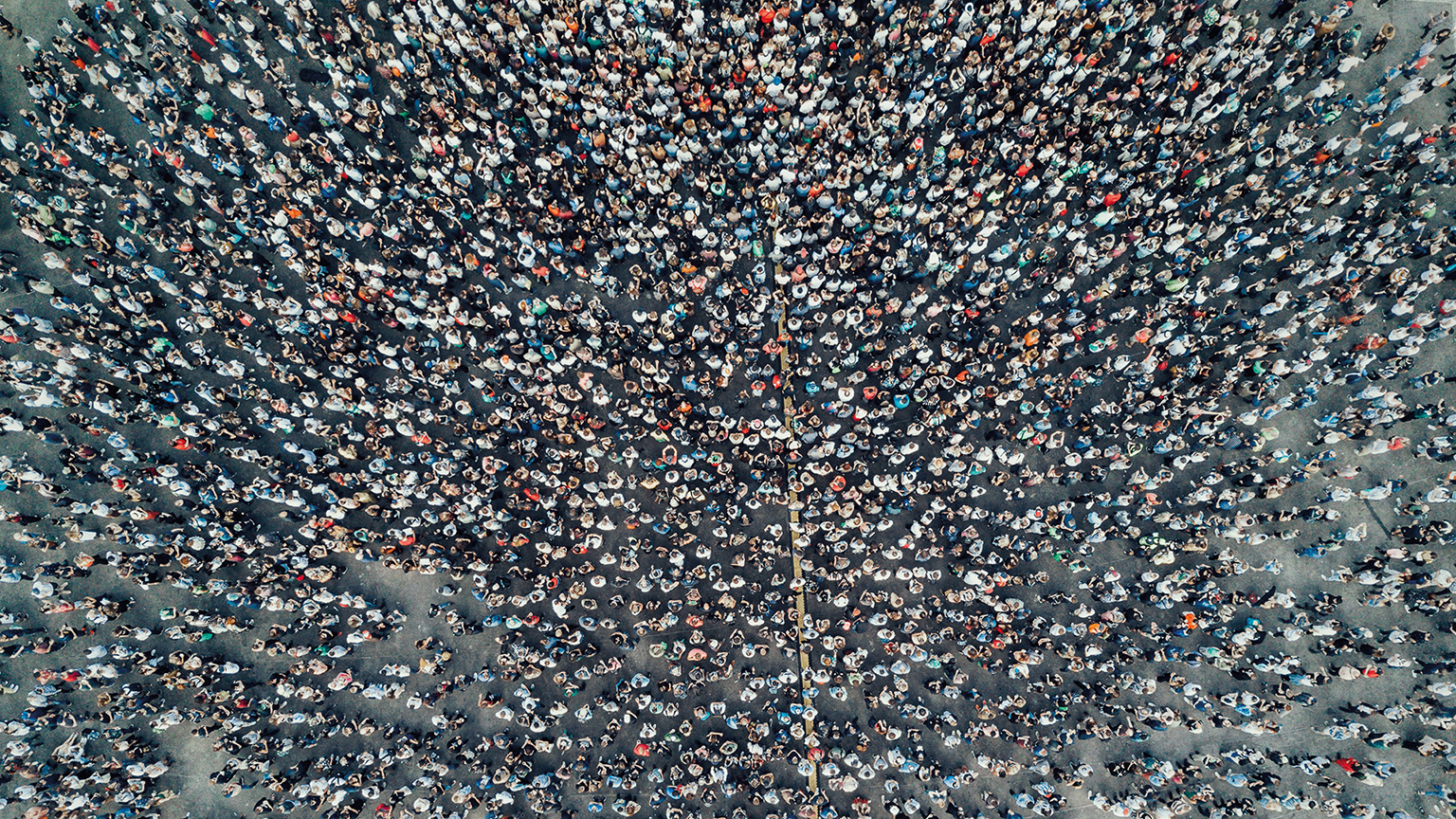
Many would have us believe that our planet is over-populated and we are putting an ever-increasing strain on its limited resources. But while we are right to be concerned about our environmental impact, we should be wary of giving credence to a belief in global overpopulation that has frequently been used to excuse inhumane political programs, some of which persist today.
Since the time of Thomas Malthus in the early 1800s, people have worried that the population will eventually outgrow the food supply. In the 1960s, biologist Paul Ehrlich visited the crowded streets and slums of New Delhi, an experience that prompted his book, The Population Bomb, which predicted an imminent population crisis and fuelled panic around the globe.
In 1983 the United Nations gave its first ever population awards to both the Chinese minister for population and the prime minister of India for their family planning and sterilisation programs. In his acceptance speech, China’s family planning chief said that “the establishment of the United Nations population award is a far-sighted move to inspire people to engage in population activities and to contribute to the solution of the population problem”. That year a record number of birth control surgeries were performed in China, including 16.4 million female sterilisations and 14.4 million abortions.
The Bible teaches that every person is created in the image and likeness of God—we are each a precious soul endowed with dignity and worthy of respect. The miracle of life, from the time of conception, is something that should move us to awe and worship of our Creator. But a belief in overpopulation has led to practices that contravene the dignity of the human person and the right of each couple to choose their own family size.
A number of political regimes have compelled people to have fewer children. For instance, China’s one-child policy resulted in the abortion of girls, forced sterilisations and selective breeding for “preferred” characteristics, often under the vigilant eye of local officials who intruded so far as to monitor women’s fertility cycles.
A belief in overpopulation has also led to large amounts of aid money being spent on population control at the expense of other health programs. For instance, Dr Stephen Karanja, an obstetrician and former secretary of the Kenyan Medical Association, wrote in 1997:
“Our health sector is collapsed. Thousands of the Kenyan people will die of malaria, the treatment of which costs a few cents, in health facilities whose shelves are stocked to the ceiling with millions of dollars’ worth of pills, IUDs, Norplant, Depo-Provera, and so on, most of which are supplied with American money. . . . Special operating theatres fully serviced and not lacking in instruments are opened in hospitals for the sterilisation of women while in the same hospitals, emergency surgery cannot be done for lack of basic operating instruments and supplies.”
There has been a recent resurgence of academics in favour of population engineering for the purpose of climate change and emissions reduction, and many countries still exercise population control. So does the world actually have an overpopulation problem?

Hadynyah—Getty Images
Unsustainable growth?
It is true the world’s population is growing, but the rate at which it is growing has been decreasing since its peak in the 1960s. Global fertility is currently 2.4 children per woman, just above the replacement rate of 2.1 children per woman necessary to sustain the current population.
In fact, many countries around the world are now battling the negative consequences of a falling population. Fertility has declined worldwide to unprecedented levels since the 1970s, and by 2011 total fertility was below 1.4 children per woman in about half of the world’s developed countries. Shockingly, according to the UN, if it wasn’t for migration, half the countries in Europe would lose 95 per cent or more of their population by the year 2300 and virtually cease to exist.
Currently, most of the world’s population growth is coming from Africa, where people use far fewer resources and create far fewer carbon emissions than the average Westerner.
There are differing long-range population projections as there is still no reliable method for accurately predicting fertility rates and mortality a generation or more from now. The UN projects that the world’s population will likely reach 11.2 billion by 2100, and that there is a strong probability that it will stabilise and decrease slightly soon after that. A recent comprehensive study by the International Institute for Applied Systems Analysis in Vienna estimated that global population will likely start to shrink from around 2070.
So, in short, those shocking graphs of predicted exponential population growth we used to see a few decades ago are no longer accurate. The simple fact is that human population numbers are stabilising.
Are we there yet?
Yet, discussing growth doesn’t answer the question of whether the world is in fact overpopulated. Overpopulation describes a situation where the number of people exhausts the resources in a closed environment such that it can no longer support that population.
So, even if the world’s population was projected to continue to increase hugely in the long term (which it is not), that wouldn’t necessarily mean that the world’s population is soon going to overwhelm the available resources.

Witizia—Pixabay.com
In thinking about overpopulation, we could first think about physical space. It is difficult to argue that there is not enough space for more people because if everyone lived as densely as they do in Manhattan, the entire population of the world would fit in New Zealand, leaving the rest of the planet free of people!
Secondly, each person needs enough food and water. But there is currently no relationship between growing numbers of people and growing hunger. Since 1990, the absolute number of chronically hungry people in the world has dropped by nearly a fifth, while at the same time two billion people have been added to the world’s population.
We also have a far higher standard of living than people living 100 years ago, yet over that time the population has trebled. Oxfam identified in a recent study that overconsumption, the misuse of resources, conflict and waste are to blame for global hunger, not overpopulation. Moreover, about one-third of the food produced for human consumption each year is wasted. This also amounts to a major squandering of the resources that go into producing food, including water and energy.
Water scarcity is another serious humanitarian issue, but again one not necessarily linked to population. Water is often used inefficiently due to pollution, conflict, inadequate infrastructure and overuse. Irrigation is the largest water user, predominantly to grow food. Water is also very heavy and can be difficult to move, contributing to local water scarcity. Thus, it requires investment in efficient infrastructure to ensure everyone has access to fresh water.
It’s important to remember that human beings are highly innovative. Technological advances in food production, such as the unforeseen “green revolution” of the 1960s, will likely continue to increase our ability to produce more food on poor quality soil and marginal land. And research shows that for every US$1 spent on canal modernisation, between $3 and $5 in conserved water can be achieved. The desalination of sea water is another example of human innovation, the cost of which is continuing to decrease with new technology.
Energy is another resource that humans increasingly depend on with the rise of electricity, motor vehicles and manufacturing. But new technology is continually changing how we use energy, and renewable and lower carbon energy sources are becoming more available. For instance:
• There is a 2–3 per cent improvement in vehicle efficiency every year. Consumers could continue to trade in their SUVs for smaller cars, hybrid vehicles, cars that run on alternative fuels or bikes (transportation accounts for almost a quarter of global greenhouse-gas emissions).
• Ultracapacitors are a possible future alternative to batteries. They work with almost 100 per cent efficiency and store electrical energy much more efficiently than has been possible in the past.
• There is increasing interest in houses that produce electricity and sell it back to the grid through their own production and efficient use of energy.
What future?
It’s the richest 10 per cent of people who produce half of all climate-harming fossil-fuel emissions, while the poorest half contribute a mere 10 per cent, making it difficult to argue that emissions are an overpopulation problem. There are many behaviours we could change before laying blame on overpopulation.
Yet, there is one resource that is becoming more scarce: working-aged people. Declining workforces and a growing elderly population are global economic problems—many countries increasingly rely on migrants to sustain their labour forces. After decades spent forcibly curbing population growth, Chinese state propaganda slogans now exhort couples to “Have children for the country”, and Denmark recently ran a humorous “Do it for mum’’ advertising campaign along similar lines.
It’s interesting to note that both Paul Erhlich and Mother Teresa experienced the same crowded Indian streets, yet their responses were completely different. Erhlich said we need fewer people; his forecasts sparked widespread population control that had little regard for the dignity of people or new life. But Mother Teresa had a different response. When asked why there is poverty and suffering in the world she simply said that it’s because we don’t know how to share. Surrounded by poverty, day in and day out on the crowded streets of India, her view remained firm: “The child is the beauty of God present in the world, that greatest gift to a family.”
Shannon Roberts is a freelance writer and busy mum of three. She lives in Auckland, New Zealand.









